Segregated by the Wheel of Inequality in Spain: How Impoverished Neighbourhoods Become Hotspots for the Lower Educated
The translated publication of the project is embedded below. Underneath, find the full text.
The percentage of people with only basic education skyrockets in the poorest neighbourhoods, the final link in a cycle that repeats generation after generation, cutting off opportunities for families with fewer resources.
Iker, 20, was born and raised in Pajarillos, a neighbourhood in Valladolid, in a family where both parents had only basic education. He attended high school in the nearby municipality of La Cistérniga—a time he doesn’t look back on fondly. “I thought about dropping out of secondary school (ESO) many times. I even had to repeat the second year, but in the end, I made it through. But actually sitting down to study? I never did. I never liked it, and I don’t think I ever will,” he admits.
Milagros, 52, was born and raised in a family of 12 siblings in Catalanes, a mountainous, rural village on the island of Tenerife. She did her basic education (EGB) at a boarding school several kilometres from her home, where her good results earned her a scholarship to continue her studies. However, her family prevented her from doing so. “My parents believed that a woman was not meant to study, that her role was to be a good wife,” she recalls.
Elsa, 31, grew up in a working-class family without formal education in the Albericia neighbourhood of Santander. She went to the local secondary school, where she failed seven subjects in her second year. She repeated both the third and fourth year but eventually completed her compulsory education. “At 14 or 15, I went off track a bit—that’s when I had to repeat. I didn’t even care. I got really lazy,” she admits.
Íker, Elsa, and Milagros grew up in low-income families with parents who had little to no formal education, in neighbourhoods ranked among the poorest 25% in Spain. Their educational trajectories do not differ much from those of their neighbours, most of whom also have only basic education.
The segregation of Spanish cities and the lack of residential mobility explain part of this gap. However, these barriers are merely the final link in a lifelong chain that holds back families with fewer resources.
For researchers, it is not just a question of income, but of class. José Saturnino Martínez, Professor of Sociology at the University of La Laguna and educational inequality expert, explains: “Income plays a role, but what matters most is occupation—that is, a family’s social class and socio-cultural position, which shape educational outcomes in countless ways.”
Using data, expert analysis, and firsthand testimonies, elDiario.es has traced the mechanisms of an inequality cycle that begins in childhood. Those born into families with little education grow up trapped in low-income neighbourhoods, where disadvantaged students are more likely to struggle in school.
Because they do more poorly in school, they are less likely to finish their education and tend to drop out early. Without qualifications, they secure low-skilled jobs with lower wages. With limited resources, they end up in marginalized neighbourhoods. And so, the cycle continues: their children are likely to repeat the same pattern.
In this investigation, we break down all the mechanisms that make up this wheel of inequality. From childhood to the labour market.
1. Inequality manifests in schools
If we randomly compare two students, one who comes from a wealthy family and one who grew up in a poorer environment, the former is more likely to do better at school than the latter. This is because a child’s academic performance is closely linked to their socioeconomic background.
At the age of 15, on average, pupils from wealthier families score higher in math, reading, and science than their peers from less affluent households. This pattern is reflected in Spain’s results from the PISA tests, standardised assessments taken by students worldwide at this age.
These disparities already exist at an early age. A report by the think tank EsadeEcPol concludes that, at the age of nine, students from the wealthiest families are already two years ahead when compared to those from the lowest income brackets. “It’s not something that happens in secondary school or at university—it starts very early on,” explains Marta Curull, an economist and pre-doctoral researcher at the University of Barcelona.
Judith, a teacher with over 20 years of experience in secondary schools across the Canary Islands, sees this firsthand. During meetings with primary school staff, where they discuss incoming students, certain names already come with a warning—students who are “behind” or have significant learning gaps. “The transition to secondary school is brutal,” Judith explains. “In the first year, we do our best to support them, but by the second or third year, things get much harder.”
These students, Judith says, enter secondary school “as if they were starting fourth-level Chinese in a language school. On the first day, they think the numbers are pretty and copy them down. By the second day, they don’t seem as pretty. By the fourth or fifth day, they don’t understand anymore. They are so behind that they lose the thread completely and spend six hours a day just sitting there, bored, every day. How do they end up? Frustrated” And with 30 other students in the classroom, teachers have very little room to intervene, she laments.
This situation is even more pronounced in schools where most students come from the same socioeconomic background. PISA data shows that schools with a higher percentage of students from wealthier families tend to achieve better results than those attended by adolescents from lower-income households. The following graph illustrates how this pattern plays out in high schools across the country.
The differences in academic results do not only stem from the student’s actual performance. Saturnino Martínez explains that “there is an alignment between school culture and middle-class culture, as opposed to working-class culture” and affects how schools and teachers interact with parents and how they evaluate students.
“There is a certain stigma attached to the education system,” says Curull, referencing a study published in the journal ICE. The research compared students’ school grades with their PISA test results and found that “two students with the same PISA score do not necessarily receive the same grades at school.” In general, students from lower-income backgrounds were more likely to repeat a grade.
However, students from disadvantaged backgrounds often do acquire lower levels of academic knowledge. One major reason is the level of pressure or interest parents place on education. “It’s not just about family income—it’s about long-term outlook,” explains José Saturnino Martínez. “If people believe the problem is purely financial, they’ll assume scholarships alone will solve it.”
Parents’ ability to assist their children with schoolwork is also an important factor. “Parents with lower levels of education have fewer chances to help their children with schoolwork,” says Martínez. Curull adds other key factors: “Having a quiet space to study at home or parents whose work schedules allow them to ensure their children stay on track.”
Elsa has experienced this firsthand. Although she says her parents wanted her and her siblings to study, she admits that “maybe they weren’t as strict as some of my friends’ parents.” She recalls that when she turned 15, her mother told her, “It’s up to you what you do,” and stopped pushing her to study.
Private tutoring, which is much more common among families who can afford it, also plays a role. Some of these additional educational resources are hired to support students struggling in certain subjects, but others are arranged because parents believe the school’s level of instruction is insufficient. This is particularly the case when it comes to learning a foreign language. “Historically, the level of English in public schools has been quite low, and those who speak good English often attended private language schools in their spare time” explains Curull.
Judith, a teacher with experience in schools in less affluent areas, sums it up: “The lower the economic level at home, the more hours the parents have to work. The child spends more time alone, there’s less supervision, and parents are less able to help. If there is no money, you can’t pay for extracurricular activities. If there aren’t any extracurricular activities, the child ends up on the street. It’s the system,” she concludes.
All these factors lead to higher grade repetition rates. As shown in the following graph, among the 5% of students from the most disadvantaged socioeconomic backgrounds, more than half have repeated a grade at some point.
Students who repeat grades often face stigma. “Because I repeated a year, I was always the different one—the repeater, the troublemaker,” says Iker.
What does this mean in practice? In many secondary schools in lower-income areas, the student population resembles a pyramid: there are many first-year ESO (compulsory secondary education) students, but far fewer reach the Baccalaureate level. This is because many who repeat a grade eventually drop out. According to Judith, the 2nd and 3rd years of ESO are the most decisive. These years often determine whether a student will continue their education or not. “The key age is 14 or 15,” she explains.
At this stage, a student’s environment plays a major role. “If the father hasn’t studied much, the child doesn’t have those expectations either. If they just want to start working and already have academic gaps, they stop paying attention in class. And if they can’t follow what’s being explained, what do they do?” Many choose to abandon their studies.
2. With lower grades, they drop out sooner
Elsa recalls enrolling in an adult education school to prepare for the entrance exam for a higher vocational degree in Early Childhood Education. “I had to speak English, which I wasn’t good at; math, but the difficult kind; history… I just didn’t see the point of learning those subjects for what I wanted to do. So why would I bother putting in the effort?” she reflects.
Iker also often thought of dropping out of secondary school. Later, when he tried Bachillerato, he increasingly felt out of place. He began with enthusiasm but failed three subjects, as he still remembers vividly: English, Spanish Language, and Technical Drawing. Even though he did well in other areas, “the subjects that didn’t motivate me ended up weighing more heavily—the ones that dragged me down, so to speak,” he says.
Dropping out of school is inevitably linked to academic performance. We know that students with lower grades are more likely to drop out, even if they pass everything. If your classmates consistently score higher, you start believing you’re not good enough, so you decide to enter the workforce instead, for example. If you have lower marks in primary or secondary school, it affects whether or not you will go to university,” explains Marta Curull.
When grades are good, the prospect of going to university increases among all income groups. “However, when academic performance is low, family background makes a major difference in expectations,” says Saturnino Martínez, an expert in educational inequality.
Even with the same academic results, students from wealthy families have higher expectations of attending university. Among the students with the worst grades, almost half of those in the top 20% income bracket still believe they will complete university education.
“The lower the socio-economic level, the less clear the priorities. Education often comes last,” says Judith. This is one of the factors that may explain the different expectations. Researcher Marta Curull adds: “People with educated parents are also more likely to go to university—always, regardless of their grades.”
This happens because post—compulsory education differs from compulsory education in two key ways. “First, it’s not free. Second, by the time students reach university age, they are already eligible to work. So, the cost of university isn’t just about tuition—it’s also about the income they renounce by continuing their studies,” explains Curull.
This was partly what led Elsa to pursue a vocational training program (grado medio) instead of a university degree. “I could have done teacher training, but in the end it’s four years that you’re not working, and it costs money too,” she says.
Who is most likely to go to university? In the following graph you can simulate the educational level that 5,000 adults aged 25 to 39 would reach depending on their parents’ studies, based on microdata analyses from the Survey on Essential Characteristics of the Population and Housing (ECEPOV).
Two out of every three young adults in Spain with at least one parent who has a university education also go on to university. But if their parents have no formal education, half do not progress beyond secondary school (ESO).
Milagros’ children are part of this unlikely group: they have all finished or are about to finish university. She believes her own decision to continue studying at 35 played a crucial role in shaping their education. “When my children started doing homework, I could help them because I had studied as an adult,” she explains. “And it wasn’t just about assisting them—I was also setting an example. I would tell them, ‘If I can do it at my age, you can do it too.’”
But they are the exception: only one in five children of uneducated parents graduate from university. Experts suggest that this gap is rooted in different expectations, the level of pressure to pursue further education, and the lack of role models in academic performance. Milagros, who was forced to stop studying after primary school due to her parents’ decision, recalls: “I never saw anyone at home who even considered becoming a doctor. When you grow up in an educated family, a world of possibilities opens up. In a humble family, that world is much smaller.”
In recent years, another option has gained traction. The percentage of young people from low-education backgrounds who complete higher secondary education or vocational training (FP superior) has increased slightly.
This alternative path has been the solution for young people like Elsa and Iker. Their parents wanted them to continue studying, and when university was no longer an option, they took advantage of vocational education instead.
After a few gap years and an unsuccessful attempt to resume education at an adult school, Elsa enrolled in a vocational training program (grado medio) in aesthetics. Iker is also doing a vocational training program in administration, following a failed attempt at completing his Bachillerato.
3. Lower qualifications, lower salaries
Waiter, cleaner, retail worker, and delivery driver—these are just some of the jobs Milagros, Elsa, and Iker have held. Milagros recalls how, in her early years navigating the job market without formal education, she took whatever work was available—often low-skilled and poorly paid.
Iker has now started a vocational training program (grado medio) in administration with the goal of joining the military. Even in the armed forces, he knows, the higher your education, the better your salary. Thus he describes the final cog in the wheel of inequality: in Spain, wage disparities are strongly linked to education levels.
In general, university graduates tend to earn twice as much as those with only basic education. In the following graph, with data from Spain’s Salary Structure Survey (Encuesta de Estructura Salarial) by the National Statistics Institute (INE), you can see how the median salary of those who went to university is close to €34,000 gross per year. This is twice the salary of someone with only primary education.
These income disparities are even more pronounced at the extremes of the wage scale. The lowest-paid 10% of university graduates still earn twice as much as the lowest-paid 10% of those with only basic education.
Even with the same starting salary, the career paths of someone with higher education and someone with basic education diverge drastically. “Two 25-year-olds might both be earning 800 euros, but a trainee in a law firm is not in the same position as a waiter. It’s common for someone working as a waiter to remain in similar jobs,” explains José Saturnino Martínez, an expert in educational inequality.
Among the highest earners in Spain, nine out of ten have a university degree. Meanwhile, only 4% of this top income group have no more than a secondary education (ESO) degree, according to wage data by income decile from the Labour Force Survey (Encuesta de Población Activa, EPA).
Income is not the only indicator of educational inequality. Those who have gone to university not only earn more but also tend to be less vulnerable to crises, because their income is more stable, experts explain.
But even if a person who comes from a poor neighbourhood with uneducated parents manages to overcome all the above obstacles and gets to university, they are still likely to have a less prosperous working career than their peers from wealthier backgrounds.
A study by ISEAK concluded that “coming from an affluent family increases the average salary by almost 43% compared to those from more disadvantaged backgrounds.” As Curull explains, “Factors such as having professional connections, the way jobs are found, or having more family responsibilities may play a role.”
She adds that individuals from low-income backgrounds often cannot take just any job. Their ability to accept low-paying or even unpaid internships is lower. Even if such positions provide better long-term career prospects, they simply cannot afford to take them.
With lower incomes and greater job instability, their housing options become increasingly limited, confining them to specific neighbourhoods in Spain’s increasingly segregated cities.
4. The cycle comes full circle in segregated neighbourhood
As a result, the poorest neighbourhoods in Spanish cities fill up with uneducated people. “It is not a matter of preferences, but of barriers. For example, families with fewer resources do not move to certain areas because they do not have access to the real estate market and cannot pay the rents,” explains researcher Marta Curull.
This phenomenon is exacerbated in large cities, where segregation between rich and poor neighbourhoods is more pronounced and increasing.
“Then there is the question of stigma. If a neighbourhood is classified as very poor or dangerous, teachers don’t want to go to those schools, which leads to a drop in education quality. If less public resources are invested, there are fewer hospitals, infrastructure, etc. And then there’s the issue of role models: numerous studies indicate that if your neighbours have gone to university, you are more likely to go as well,” concludes Curull.
This is where the cycle comes full circle, as many of the children of families with fewer resources will repeat the pattern. Is it possible to break this cycle? Some researchers, such as Saturnino Martínez, are optimistic: “The inequality machine is still working, but it is becoming less and less harmful. Today, more people graduate from high school, pursue vocational training, or higher education programs,” he argues.
Expanding access to education has been key: more people are completing secondary education compared to previous decades, and vocational training pathways have emerged as alternatives. “One of the characteristics of a good education system is that it has to be flexible and willing to remove barriers of entry, which is what the Spanish system has done,” argues Martínez.
Judith, after years of teaching experience in schools located in low-income areas, is also optimistic: “I think that those who were at the bottom are no longer as far down. They’ve moved closer. Ultimately, if a student leaves without finishing secondary school, that is a failure on our part,” she argues. For her, the key to breaking the cycle can be summed up in “a supportive family, a well-equipped school, and a positive peer environment.”
But she is critical of the work of educators: “We need to change the mindset among teachers. For example, we should call parents not just when things go wrong, but also when they go well—for both good and bad students. In the end, it brings joy to parents, and that joy takes root because the child sees that they have made their parents happy. We need to connect on an emotional level,” she says.
Although the chain of inequality diminishes the opportunities of families with fewer resources, it does not reduce them to zero. 25% of those whose parents completed only lower secondary education (ESO or EGB) go on to graduate from university. This is the case of Milagros’ children, who were raised in a low-income family but have managed to earn their university degrees.
Those who do not make it to university are also able to surpass their parents’ level of education. Elsa has done so with her vocational degree, though if she could go back, she would choose to study early childhood education, knowing it would lead to a better life. Iker, too, recognizes that his studies in business administration have opened more doors than if he had dropped out after secondary school. “My mother had never seen me so determined to try to get ahead. Her son, the one who used to do nothing, is now studying and working. This is the first time I truly feel focused,” he says with a smile.
This Yellow Glyphosate Map Reveals Where Farmers in the Netherlands Spray the Controversial Herbicide
This piece in 1 minute
What’s the news?
- Every year, farmers in the Netherlands spray some 42,000 hectares of land with glyphosate or similar herbicides.
- Glyphosate is used in 108 groundwater protection areas and near 96 protected Natura 2000 areas and 176 primary schools. About 700,000 Dutch people live within 250 metres of a sprayed field.
Why is this important?
- Glyphosate is harmful to biodiversity and possibly also to humans. Researchers are examining the link between glyphosate and diseases like cancer and Parkinson’s.
- The National Institute for Public Health and the Environment (RIVM) recommended better monitoring of pesticide use back in 2019, but this has not been done so far. FTM has mapped glyphosate use for the first time, together with seven regional media partners.
How was this researched?
- Fields sprayed with glyphosate turn yellow. FTM used satellite photos from the European Space Agency (ESA) and built an algorithm to detect such fields.
- FTM then combined this glyphosate map with maps of groundwater protection areas, nature reserves, and protected waters, as well as with the locations of all primary schools and some 30,000 playgrounds in the Netherlands.
- The full methodology of this research can be found at the bottom of the article.
This project is best experienced on the original project website, accessible here. The full text can also be read below.
Every spring, swathes of the Dutch countryside suddenly turn yellow and orange. Farmers then spray their fields and meadows with glyphosate to clear them and sow new crops.
Glyphosate is the active ingredient in Roundup, the world’s most popular weed killer, sold in a green bottle with a yellow cap. The drug generated sales of 1.3 billion euros for manufacturer Bayer in the first half of 2024, representing 6 per cent of the company’s total sales.
Roundup is also among the best-selling plant protection products in the Netherlands. Arable farmers are major users in the country: they account for 51 per cent of all Dutch glyphosate use, followed by dairy farmers (10 per cent) and bulb growers (7 per cent). Nine in 10 arable farmers use the pesticide. Among dairy farmers, it is about half.
But the pesticide is also controversial. Glyphosate has been found to harm biodiversity and soil and water quality, and it is associated with an increased risk of cancer and Parkinson’s.
The fact that many Dutch fields and meadows turn yellow in spring because of glyphosate use has long been known. But where it is sprayed and in what quantities are unclear, as are the risks to the environment and the threat to people’s health.
Consequently, the glyphosate debate is mainly based on anecdotal evidence.
On the animal spotting website Waarneming.nl, people in the Netherlands can report yellowed glyphosate fields under a separate category. Between 2020 and 2024, the number of annual reports doubled, although they are unverified.
The Democrats 66 (D66) party in 2022 called for photos of those yellow fields not only to be uploaded on the website but also to be sent directly to the country’s agriculture minister.
Caroline van der Plas, the founder and leader of the Farmer-Citizens Movement (BBB) characterised that plan as a “witch hunt”. Farmers’ organisation LTO Nederland was slightly more diplomatic, advising its members to dig up the yellow glyphosate fields to avoid “criticism from society”.
Following an adopted motion by D66, GroenLinks (Green Left) and Partij voor de Dieren (Party for the Animals), former agriculture minister Piet Adema promised in October 2023 to ban the “spraying to death” of fields by 2025.
Adema’s successor, Femke Wiersma (BBB), told Follow the Money last year that she was considering whether to adopt Adema’s “death spray” ban. However, during a debate on the issue in parliament’s lower house last November, Wiersma said that more research was needed before any ban could be issued.
Seen from space
The science is not yet clear on exactly where all the glyphosate sprayed on fields ends up. Back in 2019, the RIVM recommended mapping that out, followed by the Health Council of the Netherlands in 2020. So far, those recommendations have not been followed.
But the pesticide’s striking yellow hue means these sprayed fields are visible from space.
Using satellite images from the ESA, Follow the Money, together with seven regional media outlets, managed to obtain a view of all yellowed fields from the spring of 2020 – a relatively cloudless spring – in the Netherlands.
The research design allowed fields that had turned yellow due to other causes (e.g. drought or ploughing) to be excluded.
Because glyphosate adheres well to soil particles, the pesticide remains present in the environment for years – even if farmers have long since stopped spraying.
Violette Geissen is a professor at Wageningen University & Research (WUR) and leads a European research project on the effects of pesticides on nature and public health.
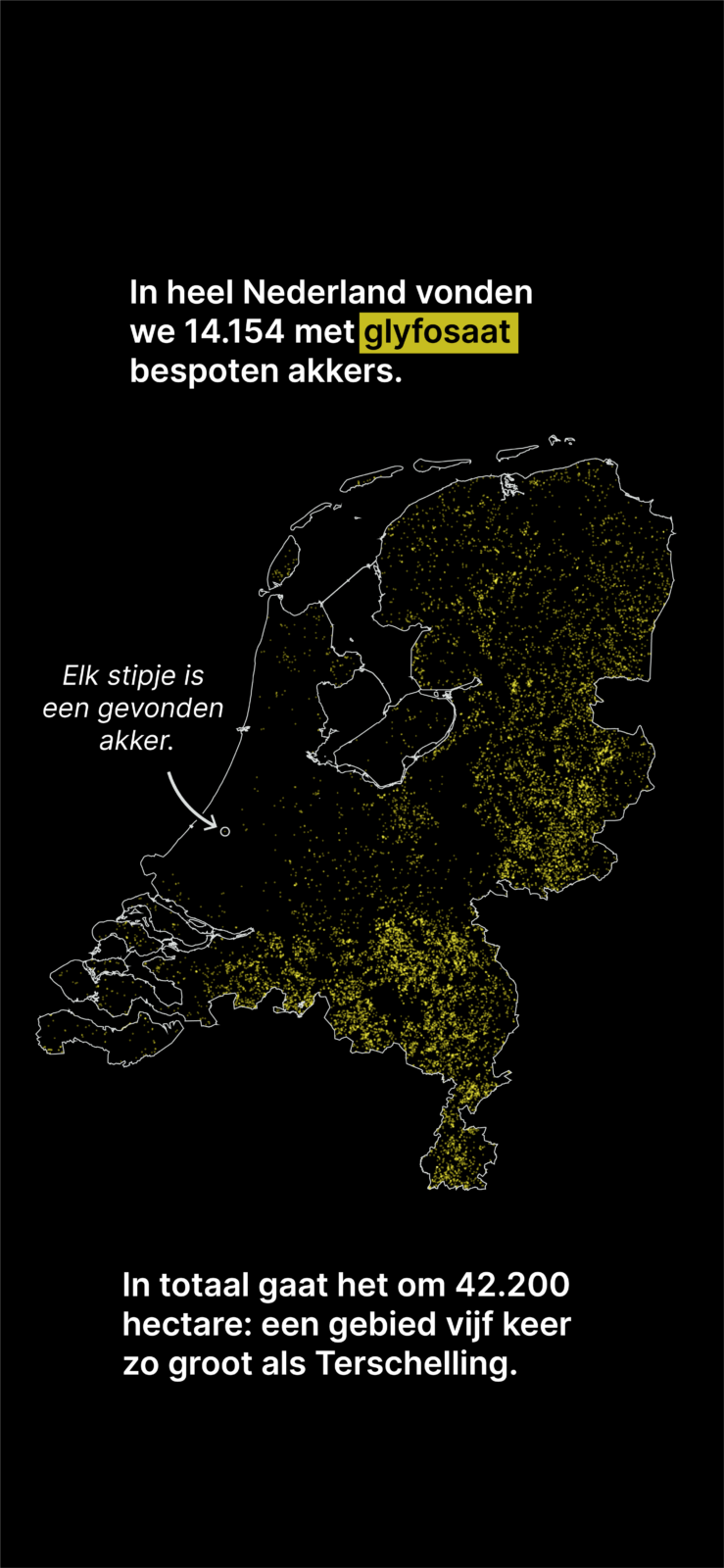
“When glyphosate comes out of the sprayer, some is carried away with the wind,” she said. “Most of that settles down within 250 metres. But then another gust of wind can carry it even further. In addition, glyphosate can bind to fine soil particles and house dust that can get everywhere via higher air layers,” she added.
Spray ban on leased land
Since 2020, eight Dutch provinces have banned the spraying of glyphosate on land that is leased to farmers. Of the fields that were sprayed in 2020, up to 5.2 per cent are now subject to a spraying ban, Follow the Money calculated.
Several other municipalities have introduced spraying bans since then. A ban has also been in place on land leased by the State Forestry Commission for some time.
In the summer of 2023, then outgoing Minister of the Interior Hugo de Jonge announced that a spraying ban would also apply to land owned by the National Forestry Service “under further conditions”. This covers about 0.2 per cent of agricultural land in the Netherlands.
A spokesperson for the National Forestry Service (RVB) said the ban applies to liberalised leases. “Annually, the RVB issues approximately between 600 and 750 hectares of land where this glyphosate ban will apply,” the spokesperson said.
Playgrounds and primary schools
What exactly are the effects of all that glyphosate?
Scientists have long suspected a link between glyphosate and a variety of diseases. France, for instance, now recognises Parkinson’s as an occupational disease among farmers.
It is “probably carcinogenic” according to the International Agency for Research on Cancer (IARC). There is some debate about that classification, as it also applies to talcum powder and even hot tea. Nevertheless, US producer Bayer has already settled with cancer patients for billions of dollars.
In 2023, the Dutch television programme Zembla reported on the scientific shortcomings in the authorisation procedure for pesticides such as glyphosate: cancer risks were ultimately found to be systematically underestimated.
Children are particularly vulnerable to pesticide exposure, says Unicef. A 2022 study found that one in 12 Dutch children is exposed to high levels of pesticide pollution. In another European study from 2021, at least one pesticide was found on almost all playgrounds analysed. Follow the Money found at least 176 primary schools in the Netherlands where glyphosate was used within a radius of 250 metres. At 1,874 schools, this was the case at a distance of less than a kilometre.
Yellow fields also turn up near playgrounds. At 490 playgrounds within 250 metres, and at 5,437 within a kilometre, according to Follow the Money’s calculations
Lazy worms and dying bees
The health risks of glyphosate to humans are still the subject of much debate. However, there is scientific consensus that glyphosate harms biodiversity.
Bees find it harder to make their way home, photosynthesis in willows deteriorates, earthworms become heavier and less active, and the growth of fungi is hindered.
A judge in the northern Dutch city of Leeuwarden ruled last year that lily growers – who use a lot of pesticides on their land – near Natura 2000 areas may have to obtain a nature licence to use plant protection products such as pesticides. Farmers’ organisation LTO Nederland fears that this ruling sets a precedent for all farmers near protected nature areas.
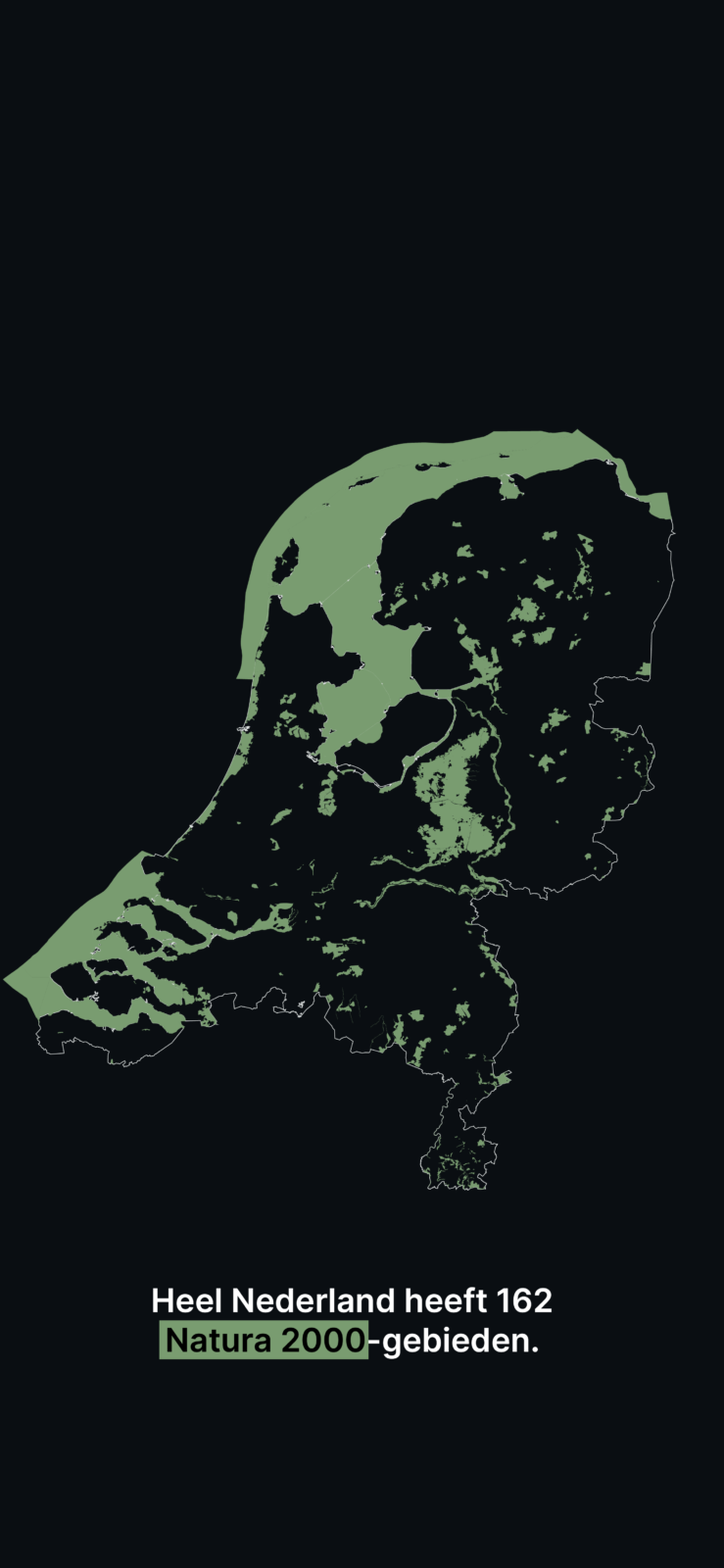
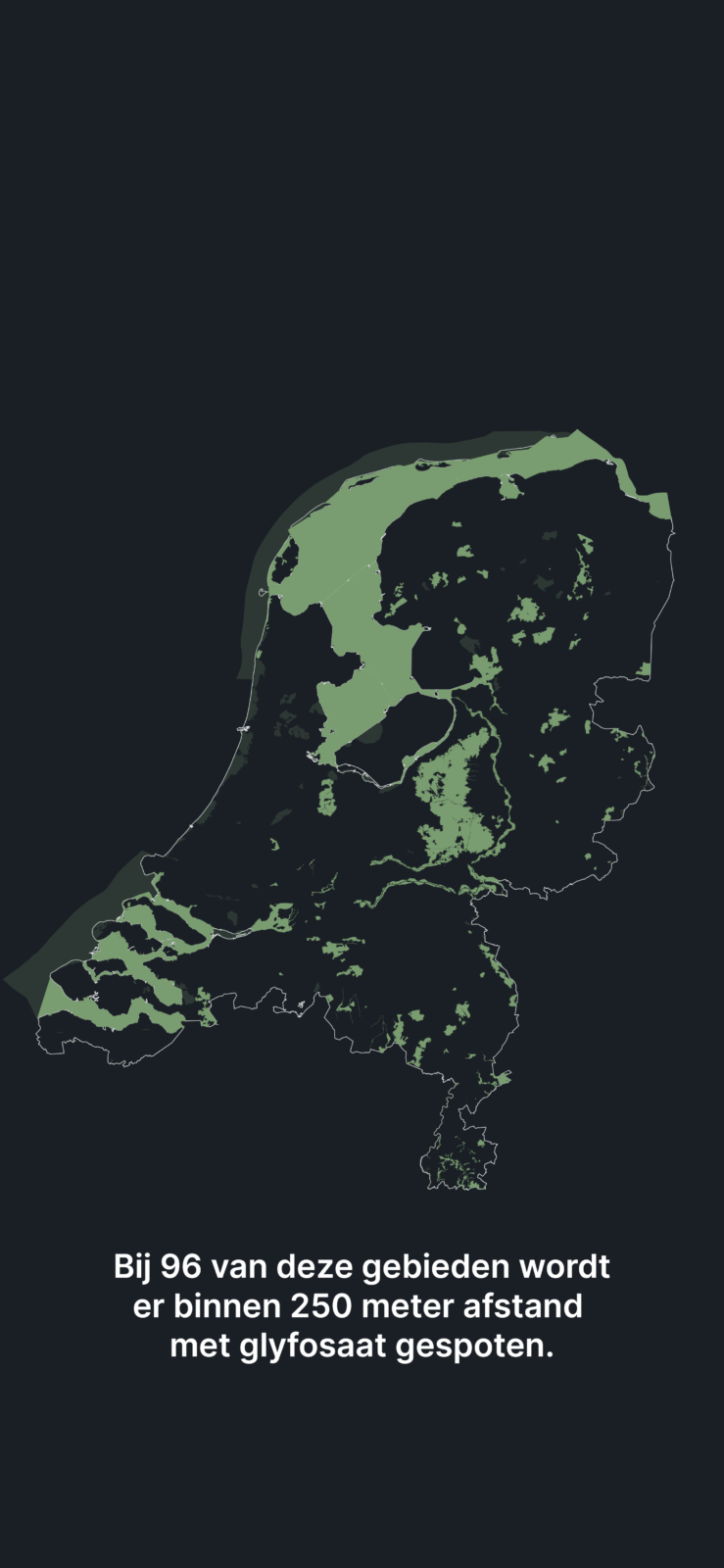
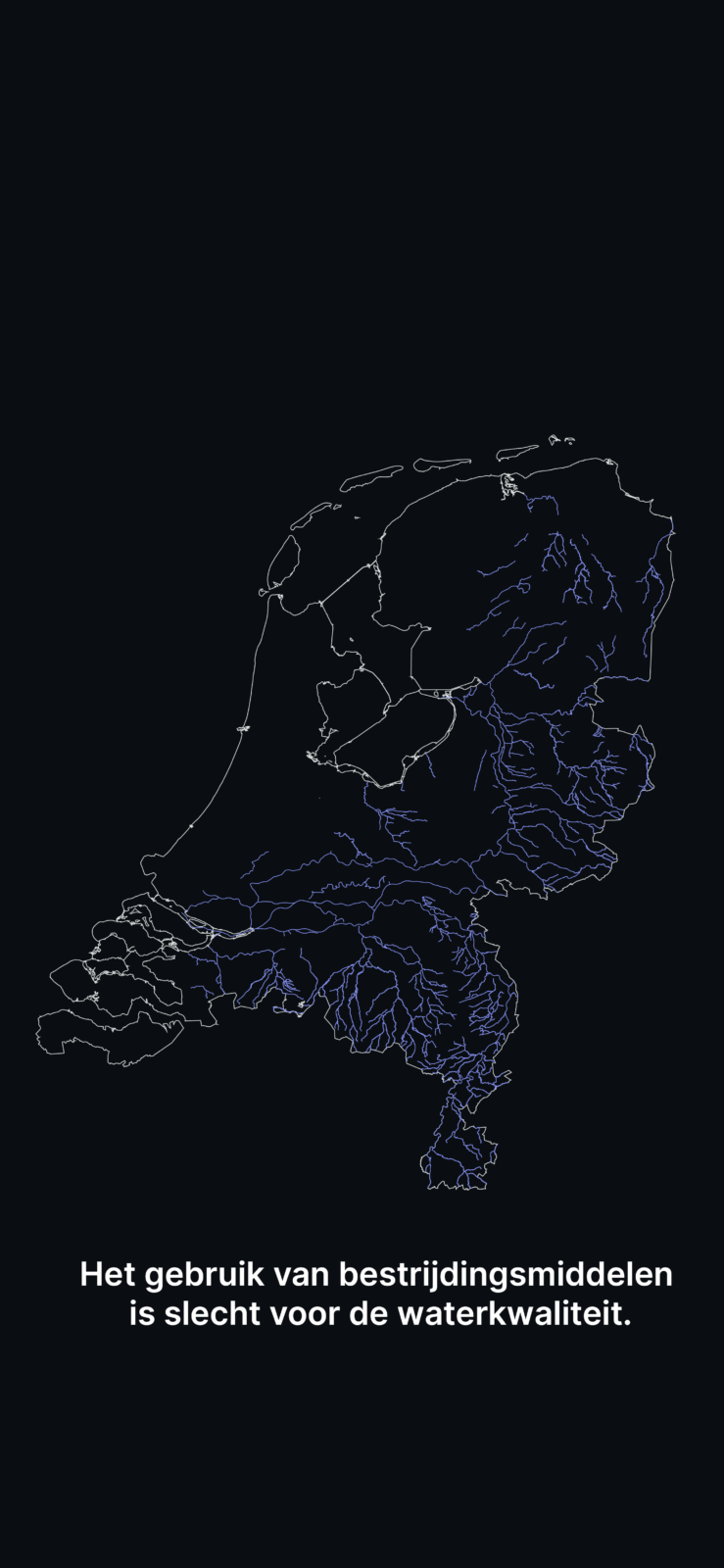
More expensive drinking water
The Netherlands has agreed with Europe that 745 Dutch waters – from small fens and ditches to the Rhine and the Wadden Sea – should be in good chemical and ecological condition by 2027.
In 2021, none of the water bodies met this requirement, partly because of excess pesticides. Things will not be much different in 2027, according to the Netherlands Environmental Assessment Agency (PBL) and the Council for the Environment and Infrastructure (RLI).
The RLI therefore called on the Ministry of Infrastructure and Water Management to tighten the rules on plant protection products.
Drinking water companies have long warned that pesticides threaten supply to the Dutch public. In 2022, no limit in the Rhine was exceeded more often than that for aminomethylphosphonic acid (AMPA), a breakdown product of glyphosate.
According to Vewin, the national association of water companies in the Netherlands, too many pesticides are found in “almost all surface water catchments and in part of groundwater catchments”.
A spokesman for Vewin said that between 2018 and 2022, glyphosate was found above the limits in “almost all surface water where drinking water is extracted”. Glyphosate was sprayed in 108 groundwater protection areas in 2020, satellite images show.
To prevent the pesticide from polluting drinking water, the supply must be treated – and that costs a lot of money, although Vewin cannot say how much.
“We have to pass those costs back to the customer,” the Vewin spokesperson said.
Take the eastern province of Overijssel, for example. There are 24 groundwater protection areas there, and glyphosate has been sprayed in 20 of them.
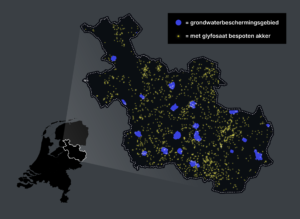
A necessary evil
Because of concerns about the safety of glyphosate, previous agriculture minister Piet Adema abstained from voting in 2023 during a European discussion on a renewed authorisation of the pesticide.
Investigations by Zembla revealed that Adema had actually wanted to vote against the measure, but was stopped by coalition partner Mark Harbers of the People’s Party for Freedom and Democracy (VVD).
Partly because of Adema’s abstention, the vote collapsed as member states did not reach a qualified majority to renew or reject the approval. Ultimately, the European Commission had to make a decision, and adopted a 10-year renewal of the approval.
In 2023, the Ministry of Agriculture, Nature and Food Quality (LNV) asked WUR to investigate alternatives to glyphosate.
The researchers concluded that while these were “mostly” available, glyphosate was “agriculturally and economically” better. Also, the alternatives would not necessarily be better for humans, environment, soil and climate. The researchers therefore described glyphosate as a “necessary evil”.
In November, Wiersma, the agriculture minister, sent a new WUR report to parliament. This found that for many applications – including the spraying to death of grassland and certain fields – alternatives do exist and that “the use of glyphosate is not necessary in many cases”. The minister wrote to the lower house that a response to the report would be forthcoming “soon”.
Bayer, the owner of Roundup, is working on an alternative to be launched on the market in 2028. The company hopes this new product will generate annual sales of 750 million euros.
So farming without glyphosate does exist. Organic arable and dairy farmers do not use chemical pesticides at all – but that also translates into lower yields per hectare. However, organic farmers are in the minority: accounting for only 4 per cent of all arable farms.
For now, glyphosate is likely to remain one of the most popular herbicides on the market. That means a “blanket of agricultural toxins” will still hang over the Netherlands, according to Violette Geissen, a professor of soil degradation and land management at WUR.
She is therefore not surprised by Follow the Money’s findings. Wherever in the Netherlands you vacuum, you will find pesticides in the hoover bag, explained Geissen.
“As long as the current form of intensive agriculture persists, there is no need to be under the illusion that you can protect nature reserves or children. The Netherlands is simply too small for that.”
Response from LTO Netherlands
LTO Nederland said in November: “LTO published a press release … in response to the attention that crop protection products are receiving at the moment. We have decided to stick to this message for now and not to go into individual questions any further.”
Methodology
This research was initiated by Follow the Money, in cooperation with seven regional media, each of which delved into their own region: RTV Drenthe, NH Nieuws, De Gelderlander, RTV Rijnmond, Omroep Zeeland, De Limburger and De Onderzoeksredactie Brabant (BN DeStem, Brabants Dagblad, Eindhovens Dagblad).
For this research, we used several datasets, including sets of cultivated crops, satellite data from ESA, and spatial datasets containing information on aspects such as the location of natural areas, primary schools and playgrounds.
To rule out that fields did not turn yellow due to drought, we used two scientific studies that investigated yellowing caused by glyphosate.
The full technical justification can be found here. The Python code is published on GitHub.
Follow the Money spoke at length with Arno Timmer of WUR about the methodology. Gerard Heuvelink and Lammert Kooistra of the WUR were also consulted.
- Ties Joosten – Leading Editor
- Robbert Hak – Editor
- Dimitri Tokmetzis – Technical Editor
- Leon de Korte – Illustrator
- Lisa Klaverstijn – Image Editor
- Rien Kort (RTV Drenthe)- Regional Editor
- Trix Pieterse (NH Nieuws) – Regional Editor
- Albert Heller (De Gelderlander) – Regional Editor
- Vincent Janssen (De Limburger) – Regional Editor
- Merlijn van Dijk (Eindhovens Dagblad) – Regional Editor
- Paul Driessen (Brabants Dagblad) – Regional Editor
- Koen Freijssen (RTV Rijnmond) – Regional Editor
- Hanneke Terlingen (RTV Rijnmond) – Regional Editor

